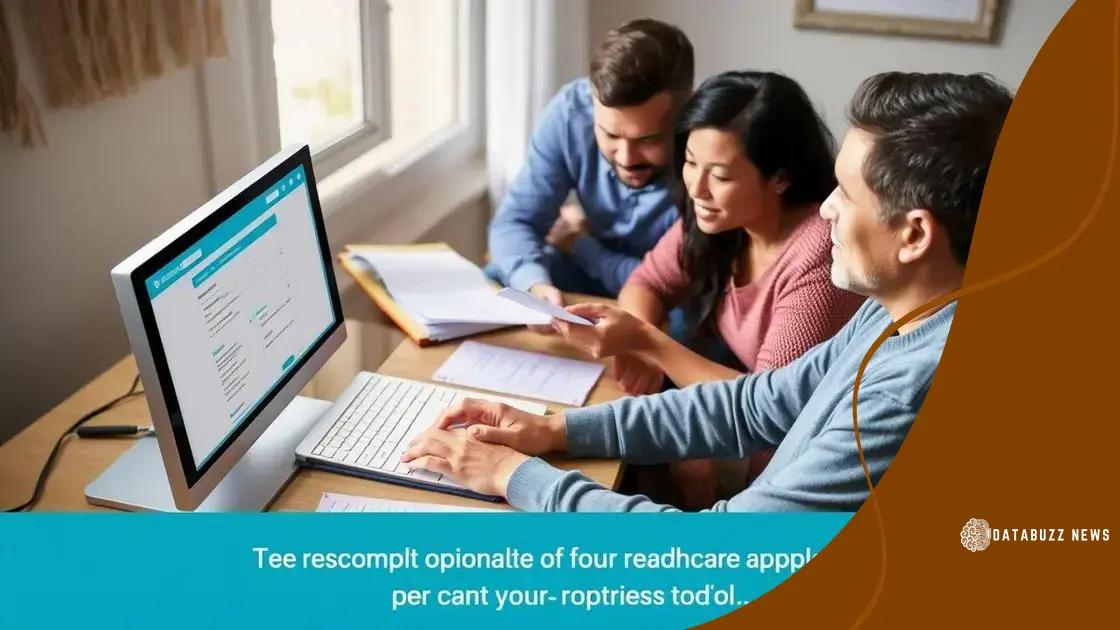Healthcare subsidy eligibility criteria you should know

Healthcare subsidy eligibility criteria primarily depend on income level, family size, and residency, requiring proper documentation to support claims and avoid common mistakes during the application process.
Healthcare subsidy eligibility criteria can significantly impact your access to essential medical services. Are you aware of what determines your eligibility? Let’s dive into the details and see how to navigate this important topic.
Understanding healthcare subsidies
Understanding healthcare subsidies can be crucial for securing affordable medical care. These subsidies help many individuals and families by reducing the cost of health insurance. Let’s explore what healthcare subsidies are and how they work.
What Are Healthcare Subsidies?
Healthcare subsidies are financial aids provided by the government. They aim to help people pay for insurance premiums and healthcare costs. These subsidies can come in various forms, such as income-based credits or direct payments to insurance companies. Knowing what type of subsidy you may qualify for can significantly ease your financial burden.
Types of Subsidies
There are several types of healthcare subsidies available:
- Premium Tax Credits: These are designed to lower monthly insurance costs based on your income.
- Cost-Sharing Reductions: These reduce out-of-pocket expenses like copayments and deductibles.
- Medicaid Expansion: Some states have expanded Medicaid, providing coverage to more low-income individuals.
- Children’s Health Insurance Program (CHIP): This program offers health coverage for children in families with incomes too high to qualify for Medicaid.
Determining your eligibility for these subsidies often requires assessing your household income and the size of your family. It’s important to gather the necessary documents before applying, as these can include proof of income and tax returns.
Eligibility Requirements
To qualify for healthcare subsidies, your income usually needs to fall within specific ranges. For instance, many subsidies are available to those earning between 100% and 400% of the federal poverty level. Additionally, other factors may influence your eligibility, like residency and family size.
Moreover, understanding the enrollment periods is essential. During open enrollment, individuals can apply for subsidies without restrictions. Missing this window may limit your options for obtaining affordable healthcare throughout the year. Keeping track of these dates can provide many benefits in terms of accessing the necessary care.
In conclusion, having a clear understanding of healthcare subsidies can empower you to take charge of your medical expenses. By investigating the types of subsidies and their eligibility requirements, you can make informed decisions about your health insurance options.
Who qualifies for healthcare subsidies?
Determining who qualifies for healthcare subsidies is essential for accessing affordable medical care. Many factors influence eligibility, including income level, family size, and state residency. Understanding these requirements can help you make informed decisions about your health insurance options.
Income Guidelines
Income is a critical factor when assessing eligibility for subsidies. Generally, you must meet specific income thresholds based on the federal poverty level (FPL). For example, individuals earning between 100% and 400% of the FPL may qualify. It’s important to note that these thresholds can vary yearly and depend on family size.
Family Size Considerations
The size of your household also plays a significant role in determining your eligibility. Larger families often have higher income limits to qualify for help. When calculating your subsidy eligibility, consider all members of your household, including children and dependents.
Residency Requirements
You need to be a resident of the state where you are applying for healthcare coverage. Some states have expanded Medicaid programs, while others may not offer the same options. Understanding your state’s specific guidelines can make a big difference in your eligibility.
When applying for healthcare subsidies, you’ll need to provide various documents. These may include proof of income, tax returns, and identification. Having accurate and up-to-date information can streamline the application process, improving your chances of qualifying for assistance.
It’s also beneficial to stay informed about enrollment periods. During these designated times, you have the opportunity to apply for subsidies without restrictions, ensuring that you don’t miss out on potential coverage. Missing these windows can limit your options for obtaining affordable healthcare throughout the year.
By knowing who qualifies for healthcare subsidies, you can navigate the process more effectively. Understanding the income guidelines, family size implications, and residency requirements is the first step towards securing essential medical coverage.
How to apply for healthcare subsidies

Applying for healthcare subsidies can seem daunting, but breaking it down into steps makes the process easier. Knowing how to start can lead to significant savings on health insurance costs. This guide will walk you through the application steps.
Gather Required Documents
The first step in your application is to gather necessary documents. These may include:
- Proof of Income: Pay stubs or tax returns help verify your earnings.
- Identification: A government-issued ID is essential.
- Household Information: Include details about your family members living with you.
- Social Security Numbers: Required for all household members.
Having these documents ready will speed up your application process.
Visit the Healthcare Marketplace
Your next step is to visit the healthcare marketplace. This is often done online, where you can compare plans and see which subsidies you may qualify for. Make sure to select the right state marketplace to get accurate information.
Fill Out the Application
The application itself usually involves providing your personal and financial information. Take your time to fill it out accurately. Mistakes can lead to delays or denials. As you fill it out, keep your gathered documents close for quick reference. You may also be asked about your coverage preferences and specific healthcare needs.
Once you’ve completed the application, review your information for accuracy before submitting it. This ensures that you present the best possible case for receiving subsidies.
Receive Your Results
After submitting your application, you will need to wait for your results. Typically, this process takes a few days to a few weeks. You will receive a notification of your eligibility and the amount of subsidy you can receive.
If approved, you can then choose a plan that fits within your budget. If denied, you have the right to appeal the decision. Make sure to follow the instructions provided to understand your next steps.
By knowing how to apply for healthcare subsidies, you empower yourself to access financial assistance for necessary medical services. Taking a methodical approach can simplify the process and help you secure the coverage you need.
Important documentation for eligibility
When applying for healthcare subsidies, providing the right documentation is crucial. This documentation supports your application and helps determine your eligibility for financial assistance. Knowing what to gather can make this process smoother.
Essential Documents
The following documents are typically required:
- Proof of Income: This includes pay stubs, tax returns, or any documentation that shows your earnings. It helps verify your income level.
- Identification: A government-issued ID, such as a driver’s license or passport, is necessary for identity verification.
- Social Security Numbers: You will need Social Security numbers for everyone in your household applying for assistance.
- Residency Verification: Documents like utility bills or lease agreements can serve to show your current address.
Inaccurate or missing documents can lead to delays in your application. Therefore, it’s vital to ensure that all your paperwork is correct and complete.
Special Considerations
Some applicants may need additional information. For instance, if you are self-employed, you should provide detailed records of your business income, which may include bank statements or profit and loss statements. Additionally, if you have dependents, you may need to provide proof of their relationship, such as birth certificates or adoption papers.
When gathering this documentation, be organized. Create a checklist of everything you need to submit. This way, you can confirm you’ve covered all bases before submitting your application.
Lastly, always keep copies of the documents you provide. This can help follow up on your application status or clarify any questions from the authorities handling your application. Understanding what important documentation is required for eligibility can lead to a more successful application process.
Common pitfalls in subsidy applications
When applying for healthcare subsidies, it’s essential to be aware of common pitfalls that can derail your application. Many applicants face challenges that can lead to denied requests or delays in receiving assistance. Understanding these issues can help you navigate the process more effectively.
Incomplete Applications
One of the biggest mistakes is submitting an incomplete application. Ensure you provide all required information. Leaving out important details, such as household member information or income data, can lead to automatic denials. Double-check your application before submitting it to avoid this issue.
Providing Incorrect Information
Another common pitfall is providing inaccurate information. This can happen when applicants forget to update their income details or misreport their household size. Always ensure that the information you submit is current and accurate. Inconsistencies can raise red flags and delay your application.
Missing Deadlines
Being unaware of deadlines can also impact your subsidy application. Each state has specific enrollment periods, and missing these can mean you lose your chance to apply for that year. Keep a calendar with important dates, so you’re prepared to submit your application on time.
Additionally, failing to respond to requests for more information or documentation can hinder your application. If the marketplace contacts you for further details, respond as quickly as possible to keep the process moving.
Not Seeking Help
Many applicants avoid seeking help, thinking they can handle the application themselves. However, this can lead to mistakes. Utilize resources such as local health departments, community organizations, or online support to guide you through the process. Getting assistance can clarify doubts and increase your chances of a successful application.
Avoiding these common pitfalls in subsidy applications can significantly improve your chances of getting approved for healthcare subsidies. By paying attention to detail, meeting deadlines, and seeking help when needed, you can navigate the application process with greater confidence.
FAQ – Frequently Asked Questions about Healthcare Subsidies
What are healthcare subsidies?
Healthcare subsidies are financial aids provided by the government to help individuals and families afford health insurance premiums and healthcare costs.
Who qualifies for healthcare subsidies?
Eligibility is primarily based on income, family size, and residency. Generally, those making between 100% and 400% of the federal poverty level may qualify.
What documents do I need to apply for subsidies?
You’ll need proof of income, identification, Social Security numbers for household members, and possibly residency verification documents.
What are common mistakes to avoid when applying?
Common mistakes include submitting incomplete applications, providing inaccurate information, missing deadlines, and failing to seek help when needed.
SEE MORE CONTENT
